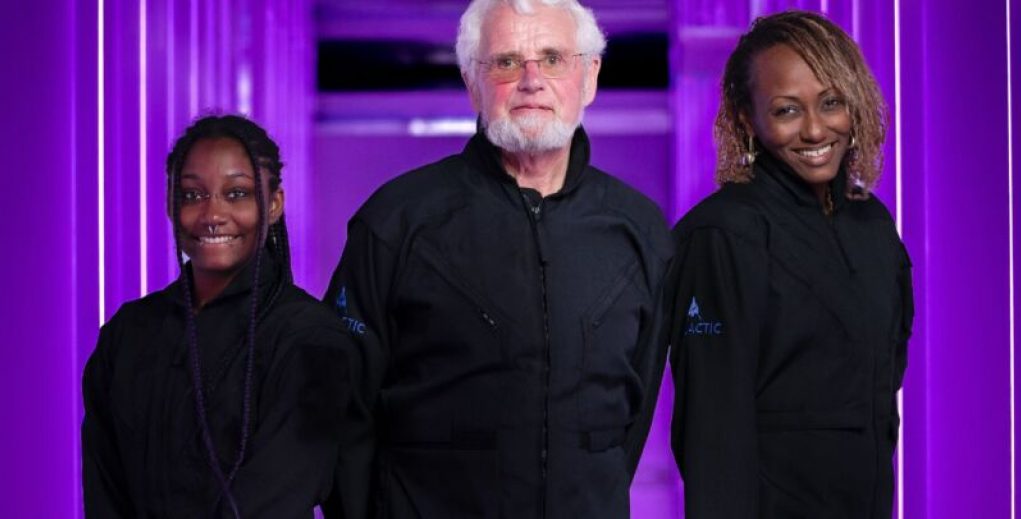Get ready for an exciting adventure! On Thursday morning, Virgin Galactic is set to make history by flying private citizens into space for the very first time.
At around 9 am local time (15:00 UTC), the company’s incredible spacecraft, VSS Unity, will be released from its carrier aircraft and soar to an altitude of over 80 km. On board will be two skilled pilots, CJ Sturckow and Kelly Latimer, along with company representative Beth Moses and three lucky private customers.
These private astronauts come from diverse backgrounds. Among them is Jon Goodwin, an 80-year-old who represented Great Britain in the 1972 Munich Olympics as a canoeist. Keisha Schahaff and Anastatia Mayers, a mother-daughter duo from the Caribbean, were given the opportunity to travel to space thanks to the nonprofit organization Space for Humanity, which aims to make space more accessible.
This will be Virgin Galactic’s seventh spaceflight and second commercial spaceflight. Their first commercial flight, which took place on May 25, carried three members of the Italian Air Force.
The spacecraft will initially take off attached to the impressive carrier aircraft, VMS Eve. It will take approximately an hour for the vehicles to reach the drop altitude of 47,000 feet (a bit higher than 14 km). Just before the spacecraft is released, it will switch to internal power.
Advertisement
Experience the Ride
Prepare for an exhilarating journey! When VMS Eve releases VSS Unity, it won’t simply drop. Due to their similar masses, the aircraft will rapidly climb as its weight decreases. Meanwhile, Unity will continue to fly horizontally.
Once the aircraft is clear, Unity will ignite its rocket engine and burn for about 60 seconds. The first 10 seconds will involve horizontal acceleration before the pilots pitch the vehicle upward, reaching a nearly vertical attitude and flying straight through the top of the atmosphere. Passengers will experience approximately 3 Gs of force.
Unity and its passengers will then enjoy around three minutes of weightlessness as they coast to an altitude between 80 and 85 km. Afterward, they will begin their descent. During this phase, passengers will experience no forces, no movement, and no noise. It’s a truly magical moment to float freely above the world, gazing both down and up.
The return journey to Earth takes about 15 minutes, during which Unity acts as a glider, gracefully returning to the three-mile long runway in southern New Mexico from which its carrier aircraft took off just over an hour earlier.
Starting at 9 am Mountain Time (15:00 UTC), Virgin Galactic will livestream the flight. Ars will be on hand to witness this historic event and provide a full recap afterward, along with an in-depth look at how the company plans to capitalize on the commercial space tourism industry.
On April 5th, the American aerospace manufacturer Virgin Galactic announced that it will be sending the first-ever private astronauts to space. The company will be partnering with a private spaceflight customer, Space Adventures, and disrupting the space travel industry. This will mark the first time that a commercial orbital human spaceflight will take place outside of a government-run program.
Virgin Galactic will be using its Space-ShipTwo Unity spacecraft to transport the crew and has already announced the names of the private astronauts – two of whom are millionaires. During the flight, the two passengers will experience four minutes of weightlessness and will even have the opportunity to conduct their own payload experiments.
This newly established partnership between Virgin Galactic and Space Adventures offers a unique opportunity for individuals who may not be able to take part in government-run spaceflight programs. They can now experience the sensation of leaving Earth’s atmosphere in a safe and fun way.
The partner structure now established between Virgin Galactic and Space Adventures is indicative of an entire shift in the space industry, from a large government-run program to a private sector. Such a partnership allows for commercial entities to engage in space exploration without relying on governmental support, further reducing the cost of spaceflight and allowing more people to take part in space missions. And, as more private spaceflight missions launch, human presence in outer space is expected to increase.
At this time, there is still no confirmation as to the date of the private astronaut mission, but preparations are well underway, and Virgin Galactic and Space Adventures are looking to launch as soon as possible. All eyes will be focused on this important event, which will be a milestone in the history of space exploration.




















